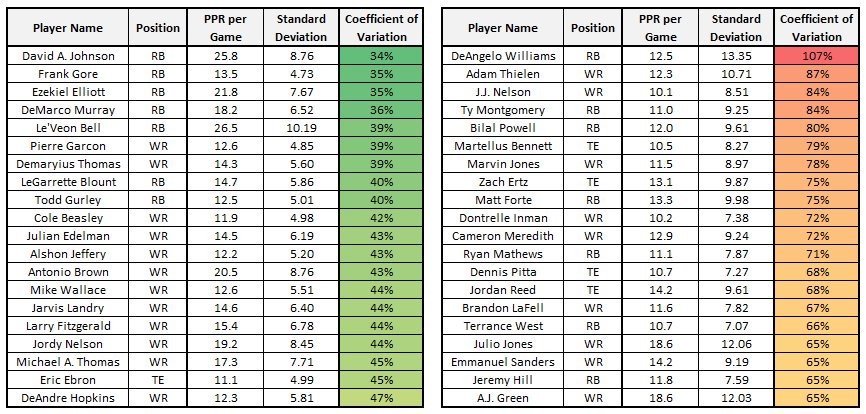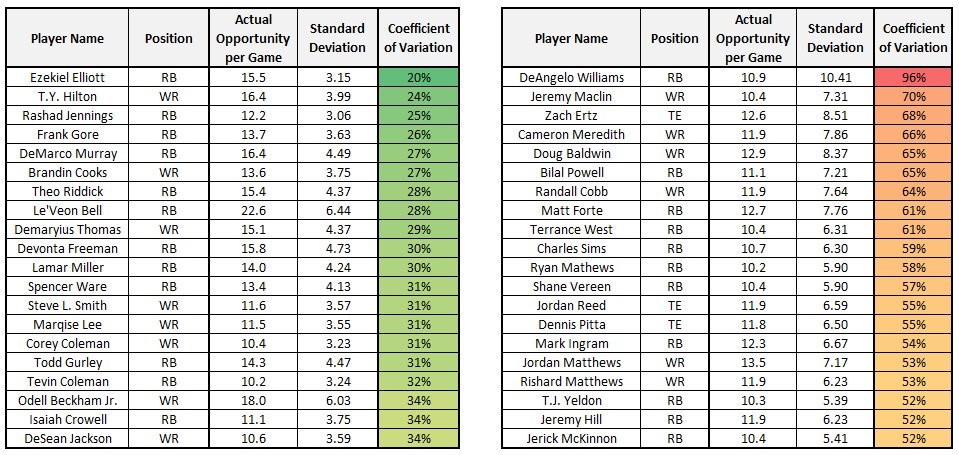(“Metrics that Matter” is a short feature that appears every Tuesday, Wednesday, and Saturday, highlighting a notable fantasy lesson to be learned from PFF’s advanced stats.)
This marks the 26th installment of Metrics That Matter. Each episode we look at a unique statistic (typically developed using PFF statistics available via a PFF Elite subscription) and try to determine what this statistic means for both fantasy and real-NFL purposes. I have a large Word document with enough ideas and statistics to ensure I won’t run out of content until sometime in late September. However, sometimes I like to deviate from this and tackle something that’s been consuming my mind at the time of writing. In this case it’s fantasy consistency.
Tristan Cockroft does this every year for ESPN, as does John Paulsen for 4for4. I’m going to approach this in a similar way to Paulsen. Looking at every player in every week over the course of a full season, we can calculate their standard deviation – to determine how much variation there was in their PPR scoring on a week-to-week basis. Now, this isn’t very helpful on its own. If a player scored exactly four fantasy points in every game they played, they’ll appear very consistent, but four fantasy points per game isn’t something to get excited about. So we’ll divide a player’s standard deviation by their fantasy point-per-game average to determine coefficient of variation.
Here were the top- and bottom-20 non-quarterbacks by coefficient of variation last season:
David Johnson ranking so highly shouldn’t come as a surprise. He scored at least 16 fantasy points in every game he started and finished last season. In the 15 games prior to his Week 17 injury, Johnson finished among the top-five fantasy running backs nine times, as well as 14 times in the top-12, and 15 times in the top-24.
DeAngelo Williams finishing last in consistency isn’t surprising either, he averaged 2.3 fantasy points per game across the four games both he and Bell played, and 22.8 fantasy points per game when Bell was sat out.
This is cool, and definitely fantasy-relevant, but I wanted to do more with this and also look at the consistency of a player’s role. Players with a consistent role are more easily projectible and less frustrating when making tough start/sit decisions in redraft leagues.
Thanks to Actual Opportunity, we can quantify the value of a player’s role for fantasy. Looking at a 10-year sample size, we can build out a player’s expected fantasy points for any specific week or season based on their carries (what down and distance it was and how far from the end zone a player was when the ball was snapped) and targets (how many yards the ball travelled through the air and how far from the end zone a player was when the ball was snapped.)
Here were the top- and bottom-20 non-quarterbacks by coefficient of variation of fantasy role last season:
Frank Gore was one of the most consistent fantasy players in terms of both production and volume last season. Gore saw between 12 and 24 touches in 14 of his 16 games, and scored between 7.5 and 21 fantasy points in 14 of his 16 games.
DeMarco Murray, like Gore, was very consistent in both scoring and opportunity. He failed to finish outside of the top-24 running backs in only two weeks. He also saw between 16 and 32 touches in every game but one.
Although Ezekiel Elliott ranked third in scoring consistency, he led in consistency of role. He saw between 19 and 32 opportunities in every game but one last season. When contrasting Actual Opportunity with raw fantasy points, it’s easy to see, not only how consistent his role was, but also how efficient he was given volume.
T.Y. Hilton was our most consistent wide receiver last season, totaling between 60 and 170 yards in the air and five and 13 targets in every game last season.
Brandin Cooks, like Hilton, wasn’t very consistent in scoring, but had a fairly predictable role, totaling between five and 10 targets in every game but one last season.
Zach Ertz had our least consistent role among tight ends. He saw at least 11 targets in four games, but also had four games with three or fewer targets.
Bilal Powell was inconsistent in both categories, mostly due to the large uptick in volume following Matt Forte’s late season injury. Powell averaged 7.2 touches per game over his first 12 games, but 25.8 over the final-month of the season. He led all players in touches and ranked behind only Le’Veon Bell and Aaron Rodgers in total fantasy points over this stretch.
Jordan Reed’s low ranking here is skewed by injury. Reed did not start, and played in only a limited capacity during his final three weeks of the season — averaging only 37.7 percent of the team's snaps and totaling just eight targets over this span. Outside of this, Reed saw at least six targets in every game he played but one. Outside of those final three games, Reed would have led all tight ends in targets per game (8.6) by 0.9 and fantasy points per game (16.9) by 3.1.






 © 2025 PFF - all rights reserved.
© 2025 PFF - all rights reserved.